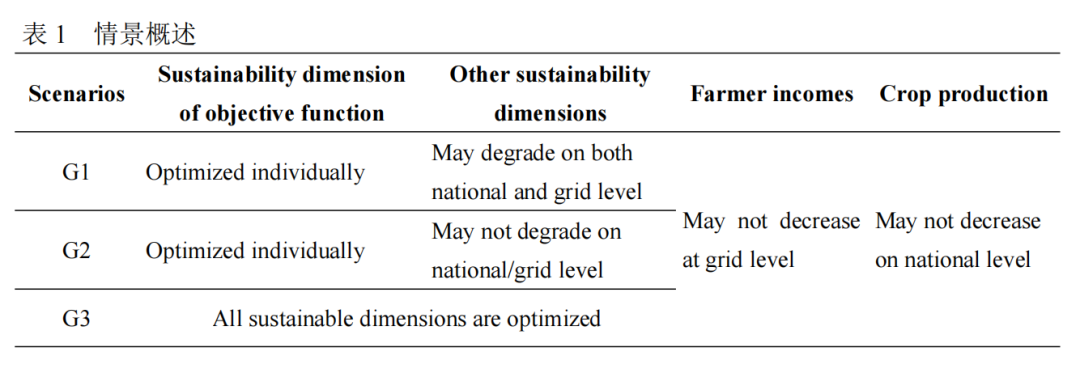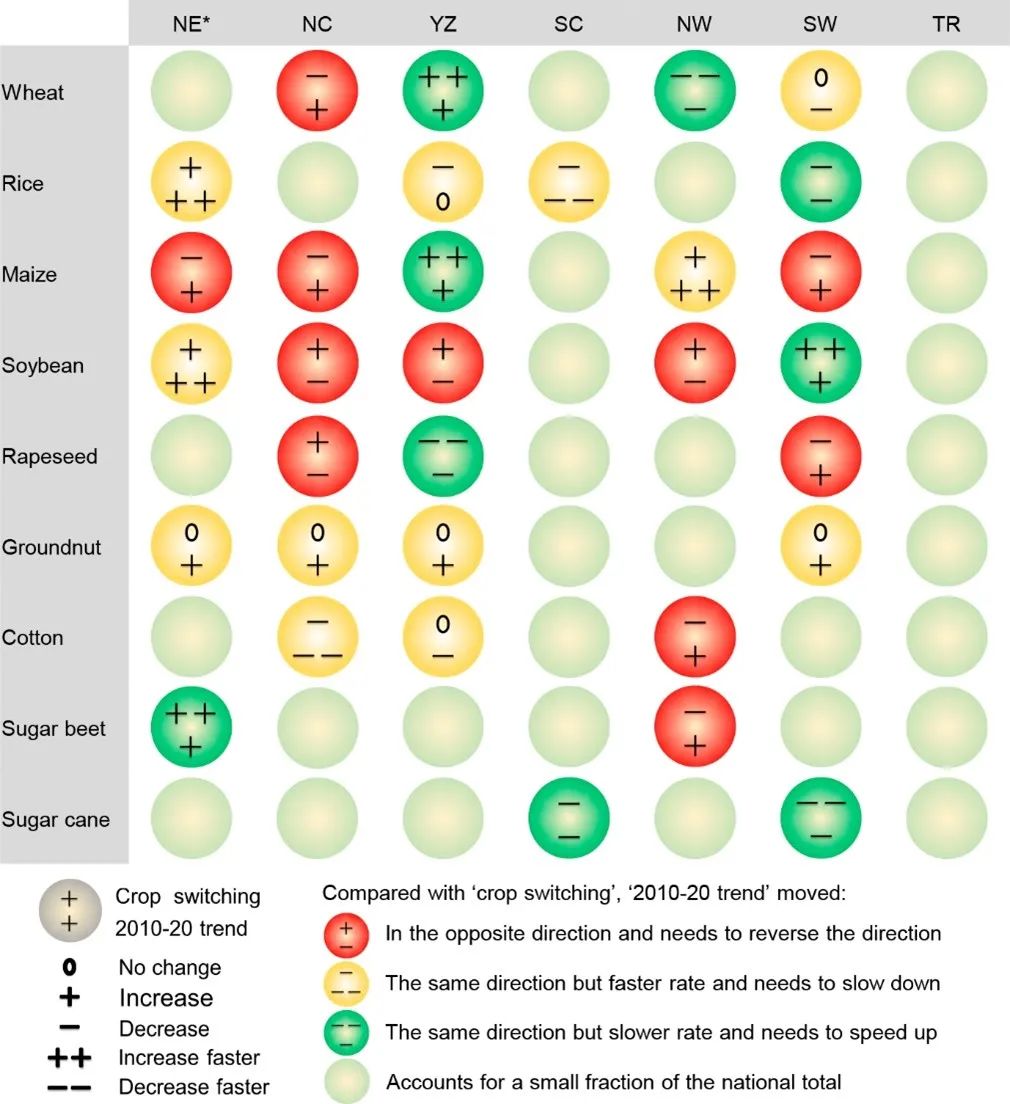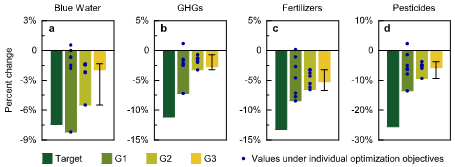current location: Home> Central News
Central News
Nature∣Research led by Xie Wei reveals that optimizing the layout of agricultural production has the potential to promote food system sustainability
Release date:2023/03/17 Source: CCAP
During the 2022 sessions of the Chinese People's Political Consultative Conference (CPPCC), General Secretary Xi Jinping emphasized "the formation of a modern agricultural production structure and regional layout that is compatible with market demand and matches the carrying capacity of resources and the environment" when he visited members of the agriculture, social welfare and social security sectors participating in the CPPCC meetings. Since the reform and opening up, China has made great achievements in agricultural production, but behind the scenes there is also an implied high intensity of resource and environmental depletion, such as the rapid decline of the water table, the increase in greenhouse gas emissions from agriculture, the sharp rise in the intensity of chemical fertilizer application, and more widespread pesticide pollution. Against this backdrop, China's administrations have introduced a series of policies and measures to improve the sustainability of agricultural development, including the Ministry of Water Resources (MWR) proposing a "red line for water use", the Ministry of Ecology and Environment (MEE) promoting greenhouse gas emission reduction in agriculture, and the Ministry of Agriculture and Rural Development (MARD) proposing a zero-growth plan for chemical fertilizers and pesticides. The above policies and measures have reduced the negative impacts of agricultural production to a certain extent, but is the current layout of agricultural production optimal? How can we optimize the layout of agricultural production to promote the synergistic development of resource conservation, environmental improvement and farmers' income? Answers to these questions are important for the sustainable development of agriculture in China and around the world.
On March 16, 2023, Xie Wei, first author and corresponding author at the School of Advanced Agriculture, Peking University, and the CCAP Peking University, published a paper entitled "Crop switching can enhance environmental sustainability and farmer incomes in China" in Nature with co-authors. The research paper entitled "Crop switching can enhance environmental sustainability and farmer incomes in China" was published in Nature (Article). The research team divided the country into 72,000 grids with 0.5°*0.5° units, and stored agricultural input and output data containing 13 crops, 8 resource inputs, and 153 groups of crop rotation patterns in 264 layers of ArcGIS spatial data, and developed a large-scale optimization of agricultural production layout based on the principle of "producing the most suitable agricultural products in the most suitable areas". Based on the principle of "producing the most suitable agricultural products in the most suitable area", a large-scale agricultural production layout optimization model was developed to carry out single-objective or multi-objective optimization of multiple dimensions of sustainable development of agriculture (crop yields, farmers' incomes, as well as water resources, greenhouse gases, fertilizers, pesticides, etc.), and to simulate the potential for emission reduction and the direction of optimization of the agricultural production layout under the cooperation mode of three different levels of management authorities (each working separately, each other, and cross-sectoral collaboration, see Table 1).

The study found that on the premise that crop yields do not decrease, farmers' incomes do not decrease, and arable land does not expand, optimizing the layout of agricultural production can lead to a significant improvement in one sustainable development indicator but a deterioration in others, if "each is on its own"; in the case of greenhouse gas emissions from agriculture, for example, it can lead to a saving of up to 17% but a deterioration in potash use by about 9% nationwide, especially in some ecologically fragile areas (Fig. 1). Potash use increased by about 9% nationwide, especially in some ecologically fragile areas (Figure 1). If "taking each other into account", optimizing the agricultural production layout has a positive effect on all the indicators of sustainable development, and the optimization of one indicator of sustainable development is no longer at the expense of other resources and the environment, but there is an imbalance in the improvement of the indicators; in the case of blue water, for example, optimizing the agricultural production layout can save up to 19% of blue water, but the improvement of the other indicators is not as good as the improvement of other indicators. In the case of blue water, for example, optimizing the layout of agricultural production can save up to 19% of blue water, but other indicators of sustainable development show less improvement, for example, the total amount of pesticides applied nationwide has only been reduced by about 4% (Figure 1). When a "cross-sectoral synergy" model of cooperation is achieved, optimizing agricultural production layout has the potential to contribute to almost simultaneous improvements in all indicators: 6.5% savings in blue water, 7.5% savings in green water, 6.5% reductions in GHG emissions, 8.1% reductions in nitrogen fertilizers, 9.8% reductions in phosphate fertilizers, 8.3% reductions in potash fertilizers, 6.7% reductions in pesticides, and a 4.5% increase in farmers' incomes. and a 4.5% increase in farmers' income (Figure 1).

Unlike previous agricultural production layouts that focused on farmers' incomes and food security, the contribution of this study is in how agricultural production should be laid out under scenarios that consider resource conservation and environmental protection. Compared with the crop layout trends in 2010-2020, the simulated agricultural production layout adjustments under the "cross-sectoral synergy" scenario have the following characteristics (Figure 2): For wheat, the key is to improve the efficiency of water use in areas where the groundwater leakage is particularly severe in North China. If agricultural water use efficiency cannot be substantially improved in North China, according to the results of the optimization model simulation, the sowing area of wheat in North China should be controlled or even appropriately reduced. At the same time, in order to guarantee the safety of wheat ration, it can be expanded in the middle and lower reaches of the Yangtze River, and even resume wheat planting in some areas of Northeast China to guarantee the safety of local ration; for rice, the viewpoint of the past ten years or so is that the Northeast China should increase the production of rice, but at present it has been growing too much, and it is recommended to control the sowing area of rice in Northeast China appropriately; for corn, moderately controlling the planting area of Northeast China and North China, and moderately expanding the planting area of the middle and lower reaches of the Yangtze River, can be a key factor in improving water efficiency. The middle and lower reaches of the planting area, can guarantee food security at the same time to promote resource and environmental conservation; for cotton, Xinjiang cotton mechanization degree is high, but to the local water resources has brought greater pressure, if in the traditional cotton area (such as, the middle and lower reaches of the Yangtze River and North China) can cultivate high-yield, easy to mechanize varieties, can be moderately restored to the production of traditional cotton areas, to alleviate the pressure on the environment of resources in Xinjiang. In addition, the optimization of the layout of oilseed and sugar crops has also been proposed (Figure 2).

Optimizing the layout of agricultural production contributes to the achievement of sustainable development goals in China and globally. According to the agricultural sustainable development goals set by the Chinese government, optimizing agricultural productivity layout saves irrigation water equivalent to 26% of the national target. In addition, it makes an important contribution to achieving the national 2030 agricultural GHG reduction target and the zero-growth targets for fertilizers and pesticides (Figure 3). At the same time, the optimized layout of agricultural production can also contribute to global food security through increased crop yields and promote sustainable global agricultural development.

Research Fellow Xie Wei from the School of Advanced Agriculture, Peking University and CCAP is the lead author of this paper, Ph.D. student Zhu Anfeng is the co-first author, and Prof. Ji-Kun Huang is the main co-author, while other co-authors include Prof. Tariq Ali from Jiangxi Agricultural University, Dr. Zhengyao Zhang from Beijing Normal University, Prof. Xiaoguang Chen from Southwestern University of Finance and Economics, Researcher Feng Wu from the Institute of Geographic Sciences and Resources of the Chinese Academy of Sciences, and Dr. Kyle Frankel Davis from the University of Delaware. Dr. Kyle Frankel Davis, University of Delaware. This research was supported by the National Natural Science Foundation of China (NSFC) YouYing Program and the NSFC Key International Cooperation Program.



 Home
Home



